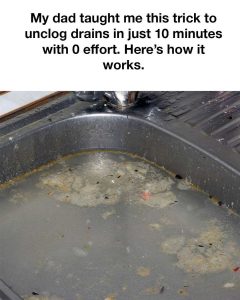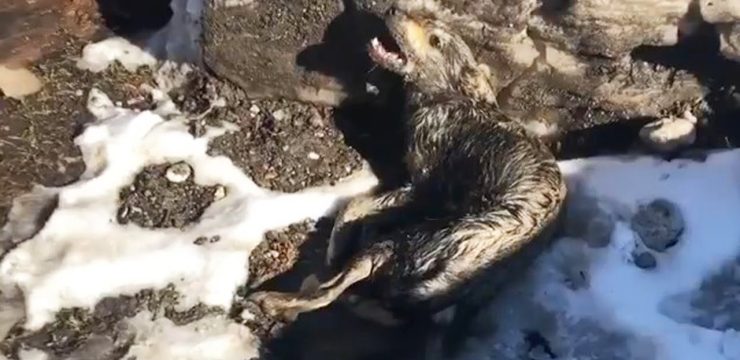Clogged drains are one of those frustrating household issues that can throw off your entire day. Whether it’s your kitchen sink refusing to drain after doing the dishes, your bathroom sink backing up during your morning routine, or your shower water pooling around your feet, it’s always a hassle. It interrupts your daily flow, creates unpleasant odors, and, if left unresolved, can potentially cause bigger problems that require expensive repairs. Most people instinctively reach for a bottle of commercial drain cleaner, but what they don’t realize is that these products often contain harsh chemicals that can corrode your pipes and pollute the environment. Fortunately, there’s a better way to handle this issue—one that’s simple, budget-friendly, and safer for your home.

This method is one I learned from my dad. Over the years, he picked up many home maintenance tricks, but this one has become a go-to in our household. It’s straightforward, effective, and doesn’t require any special tools or professional expertise. All you need are a few everyday items that are probably already sitting in your kitchen. Best of all, it takes just 10 minutes from start to finish and works like a charm on most common clogs.
Before diving into the steps, it’s worth noting why this method is so effective. Baking soda and vinegar are well-known for their cleaning properties. When combined, they create a fizzy, bubbling reaction that can help dislodge debris and residue that’s stuck in your pipes. This reaction is not only satisfying to watch but also highly efficient in breaking down clogs caused by soap scum, hair, grease, or food particles. Using boiling water before and after the treatment helps melt and flush away whatever is causing the blockage, making this method both proactive and reactive.
Let’s talk about what you’ll need to get started. The three simple ingredients are baking soda, white vinegar, and boiling water. That’s it. No rubber gloves, no drain snakes, no special tools, and no trips to the hardware store. Just basic household items you probably already have on hand.
The process is as follows: First, boil a pot of water—about four to six cups should do. Carefully pour this boiling water down the clogged drain. The heat from the water will help loosen any congealed grease or soap buildup that may be contributing to the blockage. This initial flush preps the drain for the next steps by softening up the material inside the pipes.
Next, measure out about half a cup of baking soda and pour it directly into the drain. If the drain is very slow or completely blocked, you might need to use a spoon or spatula handle to help push the baking soda down. This step is essential because baking soda serves as a natural abrasive and deodorizer, attacking the clog and neutralizing odors at the same time.
Now comes the fun part—adding the vinegar. Slowly pour one full cup of white vinegar into the drain. Immediately after, you’ll notice a bubbling, fizzing reaction as the vinegar interacts with the baking soda. This chemical reaction is powerful enough to break down grime and gunk that’s clinging to the inside of your pipes. It’s best to let this mixture sit for at least five to ten minutes. During this waiting period, do not run any water down the drain. Let the ingredients do their magic without interference.
After the fizzing has settled and enough time has passed, boil another pot of water—again, around four to six cups. Pour this second batch of boiling water into the drain to flush out the loosened debris. You should notice improved drainage almost immediately. If the drain was severely clogged, you might need to repeat the process one more time, but for most mild to moderate clogs, once is usually enough.
What’s great about this approach is that it doesn’t involve any harsh chemicals that could damage your pipes or harm the environment. It’s an all-natural solution that’s both practical and eco-conscious. Not only are you saving money on store-bought cleaners or plumber fees, but you’re also extending the life of your plumbing system by avoiding corrosive ingredients. Plus, the vinegar leaves a fresh, clean scent behind, eliminating any unpleasant odors that were lingering due to the clog.
Many people don’t realize how much of a difference small maintenance habits like this can make in a household. Regularly cleaning your drains with this method—even before you notice a clog—can help prevent future blockages and keep your plumbing running smoothly. It’s an easy, preventative measure that takes less than 15 minutes and can spare you from the stress of a full-blown plumbing disaster down the line.
Of course, there are cases where a clog may be too severe for this method, especially if the blockage is deep in the sewer line or caused by roots, broken pipes, or accumulated solid waste. In those situations, calling a professional plumber is the best course of action. But for everyday clogs and general maintenance, this simple technique can be a total game-changer.
To sum it up, dealing with a clogged drain doesn’t have to be a nightmare. With just baking soda, white vinegar, and boiling water, you can restore your drain’s flow in minutes—without harming your pipes, your wallet, or the environment. It’s quick, it’s easy, and it works. So next time you’re faced with a sluggish drain, skip the chemicals and try this tried-and-true home remedy. It might just become your new favorite household hack.





